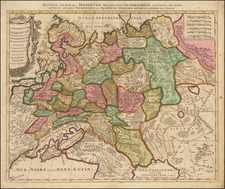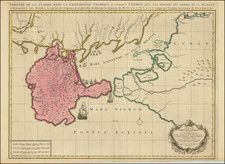Post and Gatty's Round The World Flight Crosses Russia!
Map of the USSR, published in 1931, which includes a portion of Post and Gatty's record breaking flight around the world, crossing Russia in June, 1931. The complete route went from New York via Harbour Grace (Newfoundland), Chester (England), Hanover and Berlin (Germany), Moscow, Nova Sibirsk, Irkutsk, Blagovestchensk and Khabarovsk (Russia), Nome (Alaska), Edmonton (Canada) and then back to New York.
The map shows Estonia, Lativa and Lithuania as independent states.
Leningrad and Stalingrad both shown. A note regarding Peary reaching the North Pole on April 6, 1909 appears.
Post & Gatty
In 1931, American Aviator Wiley Post asked Australian Aviator Harold Gatty to accompany him on an effort to break the world record for circumnavigating the earth, which was previously set at 21 days by the Graf Zeppelin airship. Gatty accepted, hoping to demonstrate the effectiveness of his navigation methods. The journey began on June 23, 1931, at Roosevelt Field in New York, and followed a 15,000-mile course across Europe, Russia, and Siberia, due to the lack of suitable airfields nearer the equator.
Post and Gatty crossed the Atlantic in a record time of 16 hours and 17 minutes and continued to Berlin, Moscow, and Khabarovsk, then crossed the Bering Sea, landing on the beach near Solomon, Alaska, then to Edmonton, Alberta, arriving finally back at Roosevelt Field after 8 days, 15 hours, and 51 minutes.
Rand McNally & Co. is a large American map and navigation company best known for its annual atlases. The company got its start in 1856, when William Rand opened a print shop in Chicago. He was joined in 1858 by a new employee, Andrew McNally. Together, the men established their namesake company in 1868. Originally, the company was intended to print the tickets and timetables for the trains running to and through Chicago; their first railway guide was published in 1869.
By 1870, they had shifted from just printing to publishing directories, travel guides, and newspapers. Their first map appeared in 1872 in a railway guide. The map was produced using a new wax engraving method, a cheaper process that gave the company an edge.
By 1880 Rand McNally had entered the education market with globes, wall maps, and geography texts for students. In 1923, Rand McNally published the first Goode’s World Atlas, named after its editor, Dr. J. Paul Goode. For generations afterward, this would be the standard classroom atlas.
In 1899, William Rand left the company, but McNally and his family remained, controlling the company for over a century. In 1904, they published their first road map intended for automobiles and by 1907 were publishing Photo-Auto Guides, which combined photography and mapping to help drivers. In 1924, they produced the Auto Chum, a precursor to their famous road atlases. Rand McNally would remain the leader in road maps and atlases throughout the twentieth century.
In 1937, Rand McNally opened its first store in New York City. Ever on the frontier of technology, Rand McNally pioneered the scribing process for printing tickets in 1958 and printed their first full-color road atlas in 1960. Arthur Robinson developed his now-famous projection of Rand McNally in 1969. By the 1980s, the company was exploring digital reproduction and digital databases of maps for truckers. In the 1990s, they lead the charge to develop trip-planning software and websites. Today, most of its products are available online or in a digital format, including maps for tablets and phones.









![[ Crimea ] Spezial Karte von dem Konigreich Taurien oder del Halbinsel Krim](https://storage.googleapis.com/raremaps/img/small/101372.jpg)
![[ Belarus ] Partie de Lithuanie ou sont les Palatinats de Poloczk, Witerpsk, Mseislaw, et partie de Minsk, avec le Duche de Smolensko . . . 1665](https://storage.googleapis.com/raremaps/img/small/76112.jpg)
![[ Jan Mayen Island ] Isola Di Mayen Scoperta l'Anno 1614 . . .](https://storage.googleapis.com/raremaps/img/small/99105.jpg)


![Europae Tabula VIII [Russia, Ukraine, Baltic, Scandinavia]](https://storage.googleapis.com/raremaps/img/small/86526.jpg)